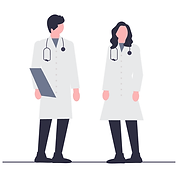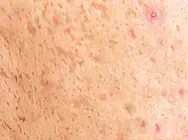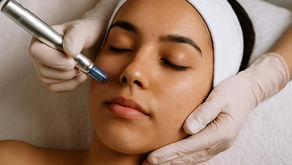KINS Clinic's Medical Acne Treatment
In Singapore, many individuals suffer from Acne. At KINS Clinic, we utilize over 30 years of clinical experience to develop a treatment protocol tailored for Asian skin. Our comprehensive approach covers treatment and skin quality improvement to prevent recurrence.
Early treatment is key to maintaining clear and healthy skin. Our expert team offers personalized care to help you achieve and maintain beautiful skin. Don't endure acne; seek early treatment. Visit KINS Clinic to restore your skin's natural beauty.

Expert Diagnosis and Treatment
At KINS Clinic, our doctors personally examine each patient and provide customized treatment plans based on individual skin types and conditions.

Science-Based Treatments
We utilize scientifically proven methods, including laser treatments, injections, prescription medications, and microbiome therapies.

Safety and Effectiveness
Our treatments adhere to strict safety standards, minimizing side effects while ensuring high efficacy.

Comprehensive Care
We offer holistic care, addressing not just acne but also acne scars and other skin concerns.

Extensive Experience
With over 30 years of experience and data from Asian skin cases, we tailor treatments specifically for Asian skin.
Developed by our experts for you

Over 30+ Years of Combined Experience helping Acne patients

Microbiome treatments formulated by our scientists at the Asia Microbiome Lab located in Japan.
What is Acne and What Causes Acne?
Acne is a common chronic inflammatory skin disorder characterised by the formation of bumps such as comedones (whiteheads, blackheads), nodules, and/or cysts on the skin.
The underlying cause of acne involves a combination of factors that affects each other. These factors include Genetic, hormonal, excessive sebum production and environmental factors which contribute to the development of acne.
Understanding these factors is crucial for formulating effective treatment strategies to help breaking the cycle of recurring acne.
Which types of acne
do you have?
Whitehead acne
Blackhead acne
Cyst acne
Papules acne
Nodules acne

closed plugged pores

open plugged pores



painful, pus-filled lumps under the skin
red bump with no pus
big, solid,
painful lumps under the skin
Stage of Acne
Severity strong
Tailored Acne Treatment in Singapore:
Customized Solutions for Your Skin
After discussing multiple skin concerns, the Acne Doctor will create a personalized treatment plan for you.

Active Acne



Teen Acne

Acne treatment before and after

Due to regulations from the Ministry of Health (MOH), we are unable to publish before and after photos of acne treatments on our website. However, you can view case photos during your consultation, where our doctor will explain the details of the treatment. Many of our patients proceed with acne treatment after understanding the process thoroughly.
You can start with just a consultation if you'd like. Please feel free to contact us!
Unsure of your acne condition?
When it comes to Acne treatment, there is no one-size-fit-all solution. Different types of treatment may be required for long-term acne control, depending on the severity and underlying causes of your condition. It is advisable to seek professional guidance early to address acne effectively before it worsens.
How to get rid of acne?
Finding the right acne treatment singapore
At KINS Clinic, we believe that acne treatments should never be one-size-fits-all.
We understand the importance of tailoring treatments to meet the unique needs of each individual.
That's why our dedicated team of doctors personalises acne treatments specifically for you, taking into account your microbiome health and acne condition.
As a general acne treatment guideline at KINS Clinic, we simplified our acne treatments into 5 "options" to help you understand and prepare you on potential acne treatments that your doctor may propose during the actual consultation.
Acne Treatment Options:

Option 1.Acne Facial Singapore
In the initial phase of treatment, our focus is on managing inflammation. Employing a tailored combination of treatment methods, medications, and post-care products, we can successfully minimize redness and inflammation in the skin.
At KINS Clinic, we use HydraFacial, a patented technology, employs vortex cleansing to purify pores and eliminate micro-blockages that contribute to pimples and acne breakouts. Simultaneously, the facial clears debris and congestion, including blackheads and whiteheads, promoting a thorough cleanse, extraction, and hydration of the skin. After clearing the skin, we utilize Blue Light Therapy to effectively kill off any P.Acne Bacteria on the skin and to strengthen the skin barrier to prevent further inflammation.
After the blue light therapy, we use our signature Aloe Vera mask to soothe redness and cool down the skin, retaining all the moisture within the skin.
As the last step of our acne facial treatment, we complete the routine with our treatment by ending with a Microbiome treatment, using KINS Signature Microbiome skincare products developed by our labs in Japan to help strengthen your skin barrier while improving cellular recovery to help you speed up your acne inflammation recovery.
Option 2.Laser Treatment for Acne
In any acne treatment plan, laser treatments play a pivotal role. Lasers effectively target P. acnes bacteria, which causes breakouts. Additionally, laser settings can be customized to target excess blood vessels around inflamed areas, including scars and pigmentation left post-acne healing.
For minimal downtime, our Vbeam laser is an excellent choice, swiftly reducing inflammation and yielding great results. A session lasts around 10-15 minutes.
At KINS Clinic, we also offer CO2 Fractional Laser Resurfacing.This laser effectively treats deeper acne scars by resurfacing the skin, promoting collagen production, and improving skin texture for smoother, healthier-looking skin.
Our Q-Switch Laser is a highly versatile treatment that addresses multiple skin concerns. It reduces pigmentation, acne scars, and post-inflammatory hyperpigmentation, while also improving freckles, age spots, dullness, and tightening pores. This laser can even be used for tattoo removal, making it a multi-functional option for overall skin improvement.
Each laser treatment at KINS Clinic is tailored to your specific skin needs, ensuring effective results for acne, scars, and skin rejuvenation.


Option 3.Acne Injection Singapore
Injection treatments are also effective option for addressing acne at KINS Clinic.
Steroid injections are particularly effective for severe inflammatory acne, especially large nodules or those with accumulated pus. By delivering steroids directly to the inflamed areas, these injections quickly reduce swelling and inflammation.
Microneedling uses fine needles to create microchannelsin the skin, stimulating natural healing processes, promoting collagen and hyaluronic acid production, and helping regulate skin turnover to control sebum secretion for smoother, clearer skin.
Skin Remodeling Treatment involves injecting hyaluronic acid and polynucleotides (PN) into the skin, encouraging cell regeneration and boosting collagen production. This treatment enhances skin firmness, elasticity, and moisture, making it more resistant to acne. At KINS Clinic, we offer personalized solutions using Profhilo, Plinest, and Skinbooster to meet individual needs.
Option 4.Acne Oral & Topical medication
Topical medications offer a variety of targeted ingredients demonstrably effective in managing acne vulgaris. Common topical agents fall into three main categories:
Topical Retinoids: Tretinoin, Adapalene, and Tazarotene are prescriptions that effectively target comedonal acne (blackheads & whiteheads) by keeping skin pores clean and preventing future breakouts.
Antibacterial Agents: Benzoyl peroxide, Clindamycin, and Erythromycin are antibiotic warriors that fight acne-causing bacteria, reducing their numbers and calming inflammation.
Keratolytic Agents: Salicylic acid, Hydroxy acid, and Azelaic acid act like gentle exfoliators, dissolving away dead skin cells that clog pores and contribute to pimples. Imagine them as pore-clearing cheerleaders, helping trapped pimples shrink and fade.


Recommended only for serious acne conditions, there are generally 3 types of oral medications that a doctor may prescribe, depending on your acne and health condition:
Oral Antibiotics: Helps your body to fight acne bacteria and reduce inflammation. Oral antibiotics like Doxycycline, Tetracycline, Minocycline, and Erythromycin tackle the P. acnes bacteria that contribute to acne, calming inflammation and reducing breakouts.
Oral Isotretinoin: Recommended for stubborn and tough acne. When other treatments fall short, oral isotretinoin, a powerful retinoid, steps in. It shrinks oil glands, clears inflammation, and tackles even severe nodulocystic acne effectively.
Hormonal Therapy: Helps balances your hormonal level to attain clearer skin. For hormonal acne, options like birth control pills and Spironolactone can be powerful allies. They help regulate hormones to prevent breakouts before they start.
Option 5.Microbiome skincare for Acne
In addition to undergoing clinical acne treatments, it is imperative to ensure that your daily skincare routine is well-balanced and tailored to your specific skin type to sustain the achieved results. Incorporating a range of Microbiome skincare products can help strengthen and boost skin recovery and prevent acne bacteria and inflammations without feeling tightness or excessive dryness.
At KINS Clinic, we offer a diverse array of topical and oral medications customized to address your unique skin condition, ensuring optimal results.
In cases of severe cystic acne and nodular acne, oral medication may be recommended.

KINS Clinic DOCTOR'S PROFILE

Dr.Henry Loh
Dermatologist and Chief Medical Advisor
Fellows of the Academy of Medicine, Singapore (FAMS) / Membership of the Royal Colleges of Physicians (MRCP) / Bachelor of Medicine and Bachelor of Surgery (BMBS)
Prior to joining KINS Clinic, Dr. Henry Loh was a co- founding partner of Dermatology Associates, one of the largest private dermatology clinic groups in Singapore. He has also been instrumental in promoting the use of the latest treatments.

Medical Director and Consultant
Post-graduate Diploma in Practical Dermatology (PgDip) / Doctor of Medicine (MD) / Bachelor of Medical Studies (BMed) / Bachelor of Science in Medicine (BSc (Med))
Dr Silver Chua specialises in the medical care of acne, rosacea, and other common skin concerns, complemented by a strong background in aesthetic treatments. She leads the fully integrated care pathway at KINS Clinic—ensuring patients receive cohesive, evidence-based care that bridges both medical and aesthetic needs. Her approach is grounded in safety, with a strong emphasis on achieving naturally balanced, lasting results.
Dr Silver is fluent in both English and Mandarin

















